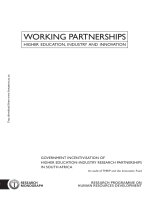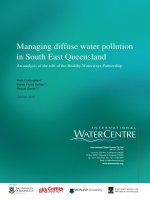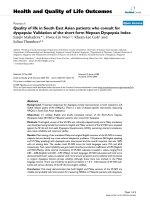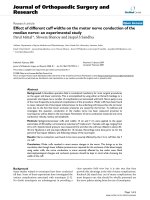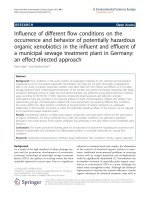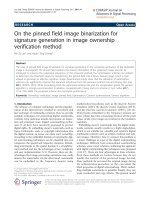Response of different seed rate on the productivity of hybrid fodder sorghum (Sugar graze) in south East Rajasthan
Bạn đang xem bản rút gọn của tài liệu. Xem và tải ngay bản đầy đủ của tài liệu tại đây (257.28 KB, 5 trang )
Int.J.Curr.Microbiol.App.Sci (2017) 6(5): 1978-1982
International Journal of Current Microbiology and Applied Sciences
ISSN: 2319-7706 Volume 6 Number 5 (2017) pp. 1978-1982
Journal homepage:
Original Research Article
/>
Response of Different Seed Rate on the Productivity of Hybrid Fodder
Sorghum (Sugar graze) in South East Rajasthan
Harphool Meena*, R.S. Narolia, Pratap Singh, P.K.P. Meena and B.L. Kumhar
AICRP on Irrigation Water Management, Agricultural Research Station,
Ummedganj Farm Agriculture University, Kota-324001, Rajasthan, India
*Corresponding author
ABSTRACT
Keywords
Sugargraze,
Seed rate and
Fodder yield.
Article Info
Accepted:
19 April 2017
Available Online:
10 May 2017
A field experiment was conducted during two consecutive years from 2014
and 2015 at Agricultural Research Station, Kota, Significantly higher green
fodder yield (907 q/ha) and dry fodder yield (245 q/ha) were observed with
sowing of Sugargraze by 9.5 kg seed/ha over local chari sowing by 10.0 kg
seed/ha green fodder yield (668 q/ha) and dry fodder yield (168 q/ha).
However, it was found at par with sowing of Sugargraze by 7.5 kg seed/ha
green fodder yield (896 q/ha) and dry fodder yield (242 q/ha).
Introduction
Sorghum [Sorghum bicolor (Linn.) Moench]
is an important crop in the world, used for
food (as grain or sorghum molasses), fodder,
the production of alcoholic beverages and
biofuels. Most varieties are drought and heat
tolerant, and are especially important in arid
regions, where the grain is one of the staple
foods for poor and rural people. It is an
important food and fodder crop grown in
India, and among cereals, it is the fourth most
important crop after rice, wheat and maize
(Dehinwal et al., 2016).
Sorghum grain is used as staple food by
millions of people and is grown for grain in
southern and central states of India, whereas
in northern states of the country (Punjab,
Haryana, Uttar Pradesh, Rajasthan, etc.) it is
mainly grown as fodder during summer and
kharif seasons as a single as well as multicut
crop. Among forage crops, forage sorghum
could be a strategic option because of the
crop’s xerophilic characteristics, adaptation
potential, quick growing habit, good ratoon
ability, palatability, digestibility and wide
range of potential uses as green fodder, dry
roughage, hay and silage (Kumar and
Chaplot, 2015).
Among crop management practices seeding
densities or plant population greatly affect
crop growth and then finally grain yield.
Therefore seeding density is a key factor in
assessing the flexibility and yielding ability of
cultivars. Both over and substandard plant
population is the major cause of low yield
(Jan et al., 2000).
1978
Int.J.Curr.Microbiol.App.Sci (2017) 6(5): 1978-1982
Optimum seed rate plays an important role in
contributing to the high yield because in case
of thick plant population, most plants remain
sterile, easily attacked by diseases as
compared to normal population (Robert and
Singh, 1981). To obtain high quality
preserved forage (silage or hay), harvest
sugargraze at knee height stage. For silage, let
plants wilt prior to ensiling and lower
moisture content will reduce effluent losses
from silage. In the India, two to three
subsequent harvests are possible. To stimulate
recovery growth, fertilize with N immediately
following the initial harvest (Smith et al.,
2005).
Materials and Methods
Field experiment was conducted during two
consecutive years from 2014 and 2015 at
Agricultural Research Station, Kota. T1:
Sugargraze (seed rate 3.5 kg/ha), T2:
Sugargraze (seed rate 5.5 kg/ha), T3:
Sugargraze (seed rate 7.5 kg/ha), T4:
Sugargraze (seed rate9.5 kg/ha), T5:
Sugargraze (seed rate11.5 kg/ha) andT6:
Local chari (seed rate 10.0 kg/ha). The
experimental field was well prepared by two
ploughing followed by harrowing and
cultivator and one planking for uniform
leveling, etc were performed for sowing of
sorghum crop. The experiment was laid-out in
RBD with four replications and six
treatments. The recommended dose of
nitrogen, phosphorus and potash i.e.125 kg
N/ha, 60 kg P2O5 / ha and 60 kg K2O /ha was
given in the form of urea, di-ammonium
phosphate (DAP) and muriate of potash
(MOP). Full dose of DAP and MOP and half
N were drilled just before sowing and
remaining half-N was applied in two split
doses as per recommendation.
The bulk density, pH and cation exchange
capacity of these soils varies between 1.30-
1.60 Mg/m3, 7.75-8.50 and 30-40 Cmol/kg,
respectively. The soils of the region are poor
in organic carbon (0.50±0.08) and available
nitrogen (275±5 kg/ha) but are low to medium
in available P2O5 (24.2± 1.0 kg/ha) and
medium to high in available K2O (290 ± 8
kg/ha).
Results and Discussion
Plant population
The plant population and growth parameters of
sugargraze were significantly influenced by
sowing of different seed rate (Table 1). Pooled
data of two years showed that the significantly
higher plant population (491886/ha) of
sugargraze was recorded with the sowing of 11.5
kg seed/ha which was significantly superior over
rest of the treatments.
Ist cutting
Two years pooled data indicated that(Table 1)
the maximum plant height (154cm), leaf
weight/plant (93.75g) and stem weight/plant
(280.65 g) were recorded with the sowing of
sugargraze by 3.5 kg seed/ha over local chari
plant height (132cm), leaf weight/plant
(70.6g) and stem weight/plant (214.15 g).
However, it was found at par with sowing of
sugargraze 5.5 and 7.5 kg seed/ha. Pooled
data of two years shows that the fodder yield
was significantly influenced by sowing of
different seed rate of sugar graze (Table 1).
Sowing of sugargraze with 9.5 kg seed/ha
were observed maximum green fodder yield
(568q/ha), dry fodder yield (153q/ha) and dry
matter (26.86%) but it was found at par with
the sowing of sugargraze 7.5 kg seed/ha over
local chari sowing with 10.0 kg seed/ha green
fodder yield (413q/ha), dry fodder yield
(109q/ha) and dry matter (25.80%) table 3.
These results are in close proximity with
those of Dehinwal et al., (2016), Smith et al.,
(2005) and Jan et al., (2000).
1979
Int.J.Curr.Microbiol.App.Sci (2017) 6(5): 1978-1982
Table.1 Effect of different seed rate on plant population, growth and fodder yield of sugargraze (Ist cutting)
Treatments
Plant
population
Plant height (cm)
Weight of leaves/ plant
(thousand/ha)
T1: Sugargraze (seed
rate 3.5 kg/ha)
T2: Sugargraze (seed
rate 5.5 kg/ha)
T3: Sugargraze (seed
rate 7.5 kg/ha)
T4: Sugargraze (seed
rate 9.5 kg/ha)
T5: Sugargraze (seed
rate 11.5 kg/ha)
T6: Local variety (seed
rate 10.0 kg/ha)
SEm ±
CD at 5 %
(g)
Green
fodder
(g)
2015
Pooled
2014
2015
Pooled
2014
2015
Pooled
156667
158400
157534
153.2
93.8
247375
246344
152.2
92.7
328750
330750
329750
150.7
408854
410900
409877
141.2
490729
493042
491886
135.5
417188
419025
418107
131.2
1102
1088
1007
1.0
153.50
5
152.38
0
151.00
5
142.25
5
136.03
0
131.99
5
1.0
93.7
245313
153.7
5
152.5
5
151.2
5
143.2
5
136.5
5
132.7
3
1.2
3318
3276
2909
3.2
3.4
2.9
2014
Weight of stem/plant
2014
2015
93.75
280.0
92.8
92.75
92.4
92.5
91.3
yield
Dry fodder yield (q/
(q/ha)
Pooled
2014
2015
281.3
280.65
386
388
279.0
280.0
279.50
424
92.45
277.8
279.3
278.55
91.4
91.35
275.3
276.0
73.5
73.7
73.6
252.5
70.6
70.6
70.6
0.74
0.73
2.22
2.19
Pooled
2014
2015
Poo
387
107
109
1
427
426
113
115
1
558
562
560
150
151
1
275.65
566
569
568
152
153
1
253.8
253.15
516
519
518
135
137
1
213.4
214.9
214.15
411
414
413
106
111
1
0.67
1.23
1.31
1.16
3.88
4.03
3.63
1.11
1.09
1.
1.93
3.70
3.93
3.35
11.70
12.14
10.48
3.34
3.29
2.
Table.2 Effect of different seed rate on plant growth and fodder yield of sugargraze (IInd cutting)
Treatments
Plant height (cm)
Weight of leaves/ plant
Weight of stem/ plant
(g)
T1: Sugargraze (seed rate 3.5 kg/ha)
T2: Sugargraze (seed rate 5.5 kg/ha)
T3: Sugargraze (seed rate 7.5 kg/ha)
T4: Sugargraze (seed rate 9.5 kg/ha)
T5: Sugargraze (seed rate 11.5 kg/ha)
T6: Local variety (seed rate 10.0 kg/ha)
SEm ±
CD at 5 %
Green
(g)
fodder
yield
Dry fodder yield (q/ha)
(q/ha)
2014
2015
Pooled
2014
2015
Pooled
2014
2015
Pooled
2014
2015
Pooled
2014
2015
Pooled
133
132
131
125
120
117
0.67
2.02
134
133
132
126
121
118
0.84
2.52
134
133
132
126
121
118
0.69
2.00
66.08
65.75
64.75
62.00
55.50
51.75
1.01
3.05
66.30
66.08
65.05
62.23
55.68
52.02
0.98
2.96
66.19
65.92
64.90
62.12
55.59
51.89
0.91
2.64
159.8
157.3
156.0
155.6
135.3
118.3
1.28
3.86
161.3
158.5
157.3
157.1
136.8
120.3
1.65
4.98
160.55
157.9
156.65
156.35
136.05
119.3
1.34
3.89
247
263
334
338
265
253
3.00
9.05
250
266
337
340
268
256
2.87
8.66
249
265
336
339
267
255
2.70
7.79
62
68
90
91
67
57
0.58
1.74
64
69
91
93
68
60
0.71
2.13
63
69
91
92
68
59
0.59
1.71
1980
Int.J.Curr.Microbiol.App.Sci (2017) 6(5): 1978-1982
Table.3 Effect of different seed rate on dry matter (%) and total green and dry fodder yield of sugargraze (Ist cutting and IInd cutting)
Treatments
Dry matter (%)
Dry matter (%)
st
Green fodder yield (q/ha)
Dry fodder yield (q/ha)
nd
I cutting
II cutting
2014
2015
Pooled
2014
2015
Pooled
Ist cutting
IInd cutting
Total
Ist
cutting
IInd
cutting
T1: Sugargraze (seed rate 3.5 kg/ha)
27.72
27.73
27.73
25.10
25.12
25.11
387
249
636
108
63
171
T2: Sugargraze (seed rate 5.5 kg/ha)
26.65
26.67
26.66
25.85
25.86
25.86
426
265
691
114
69
183
T3: Sugargraze (seed rate 7.5 kg/ha)
26.88
26.90
26.89
26.94
26.96
26.95
560
336
896
151
91
242
T4: Sugargraze (seed rate 9.5 kg/ha)
26.85
26.86
26.86
26.92
26.94
26.93
568
339
907
153
92
245
T5: Sugargraze (seed rate 11.5 kg/ha)
26.16
26.18
26.17
25.28
25.29
25.29
518
267
785
136
68
204
T6: Local variety (seed rate 10.0 kg/ha)
25.79
25.81
25.80
22.52
22.57
22.55
413
255
668
109
59
168
SEm ±
0.14
0.14
0.12
0.20
0.20
0.18
3.63
2.70
-
1.01
0.59
-
CD at 5 %
0.42
0.42
0.37
0.59
0.60
0.53
10.48
7.79
-
2.92
1.71
-
General View of Experimental plot
1981
Tot
Int.J.Curr.Microbiol.App.Sci (2017) 6(5): 1978-1982
IInd cutting
During IInd cutting plant growth was
significantly influenced (Table 2) by sowing
of different seed rate of sugargraze. The
maximum plant height(134cm), leaf weight/
plant (66.19g) and stem weight/ plant
(160.55g) of sugargraze were recorded with
the sowing of 3.5 kg seed/ha of sugargraze
over local chari plant height (118cm), leaf
weight/ plant (51.89g) and stem weight/ plant
(119.3 g) sowing with 10 kg seed/ha.
However, it was found at par with sowing of
sugargraze 5.5 and 7.5 kg seed/ha,
respectively. Fodder yield of sugargraze was
significantly influenced by sowing with
different seed rates. The maximum green
fodder yield (339 q/ha), dry fodder yield
(92q/ha) (Table 2) and dry matter (26.93%)
were observed under sowing of sugargraze
9.5 kg seed/ha but it was found at par with the
sowing of sugargraze 7.5 kg seed/ha green
fodder yield (336q/ha), dry fodder yield
(91q/ha) and dry matter (26.95%) over rest of
treatments (Table 3). These results are in
close proximity with those of Satpal et al.,
2016; Kumar and Chaplot.
In conclusion, significantly higher green
fodder yield (907 q/ha) and dry fodder yield
(245 q/ha) were observed with sowing of
sugargraze by 9.5 kg seed/ha over local chari
sowing by 10.0 kg seed/ha green fodder yield
(668 q/ha) and dry fodder yield (168 q/ha).
However, it was found at par with sowing of
sugargraze by 7.5 kg seed/ha green fodder
yield (896 q/ha) and dry fodder yield (242
q/ha).
References
Dehinwal, A.K., S.K. Pahujaand M.
Shafiqurrahaman. 2016. Environmental
effect on sorghum fodder yield and its
related traits. Forage Res., 42: pp.189194.
Jan, A., Kaleem, S.A., Taj, F.H. and Khan, H.
2000. Response of mungbean cultivars
to different seeding densities at dry land
conditions. Pak. J. Biol. Sci., 3: 203032.
Kumar, D. and P.C. Chaplot. 2015.
Performance of multicut forage
sorghum genotypes to fertility levels.
Forage Res., 41: 199-201.
Robert, W. and Singh, K. 1981. Food Grain,
A Text Book of Punjab Agriculture,
Civil and Ministry Gazette, Lahore.
287.
How to cite this article:
Harphool Meena, R.S. Narolia, Pratap Singh, P.K.P. Meena and Kumhar, B.L. 2017. Response
of Different Seed Rate on the Productivity of Hybrid Fodder Sorghum (Sugar graze) in South
East Rajasthan. Int.J.Curr.Microbiol.App.Sci. 6(5): 1978-1982.
doi: />
1982



